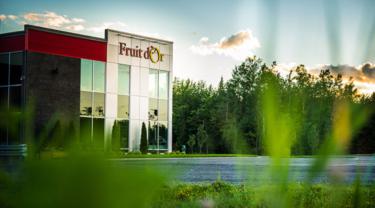In 1995, Martin Le Moine decided to make the switch to organic with his cranberry crop. When his first organic red berries were ready to hit the market, the US company with whom he was dealing to sell his products was not ready to wade into the organic market with him. It was at that time that Mr. Le Moine met Sylvain Dufour and they got the idea to create the company Fruit d’Or with the intent to create value-added products from organic berries.
They were put in touch with purchasers in Europe and the United States and began selling internationally early on, when their production was still artisanal, with a very small yield. These early partnerships are still in place, and the partners have grown with the company. Europe and the United States were the two export areas the company focused on, since the Canadian and Quebec markets were too small for the company to limit itself to.
Around the same time, cranberry production skyrocketed in Quebec, and several producers called upon Fruit d’Or to manage their production. The company therefore grew dramatically in the 2000s, making the leap from artisanal production to a modern agrifood business.
The initial dream of having a small organic cranberry farm was critical to Fruit d’Or achieving its current status as world leader in organic cranberry processing. Although the company still produces some non-organic fruit, the organic side of the business is what enables it to lead the niche market. Fruit d’Or now has a hand in producing almost two thirds of all organic cranberry products in North America.
Fruit d’Or is now present in more than 50 countries. Europe and the United States each represent one third of its exports. Asia, Oceania and countries in North Africa and South America account for 10% but are growing markets. In total, almost 80% of the company’s products end up on international markets.
The type of products chosen was also critical to the export journey taken by Fruit d’Or, who chose to showcase northern berries from Eastern Canada, namely organic cranberries and wild blueberries. That’s what enabled them to be competitive on international markets. “We wouldn’t have been able to do the same thing with strawberries or even high-bush blueberries, which are produced in much larger quantities in Western Canada,” said Mr. Le Moine. “We needed a product that was competitive for export purposes and was able to be processed in ways that met market needs.”
Those needs are rather specific and stringent in terms of standards and certifications for the food market, which you have no choice but to comply with. “The list of certifications is very long, and they can all be barriers to penetrating a new market,” added Mr. Le Moine. “We have to be audited, and our facilities have to be inspected to ensure we are complying with the standards, which means that we have to have sufficient processing capacity to meet the requirements.” He went on to say that the dried fruit market is currently mature in this regard, with well-established standards and certifications.
Learn more about Martin Le Moine and Sylvain Dufour’s export journey.





